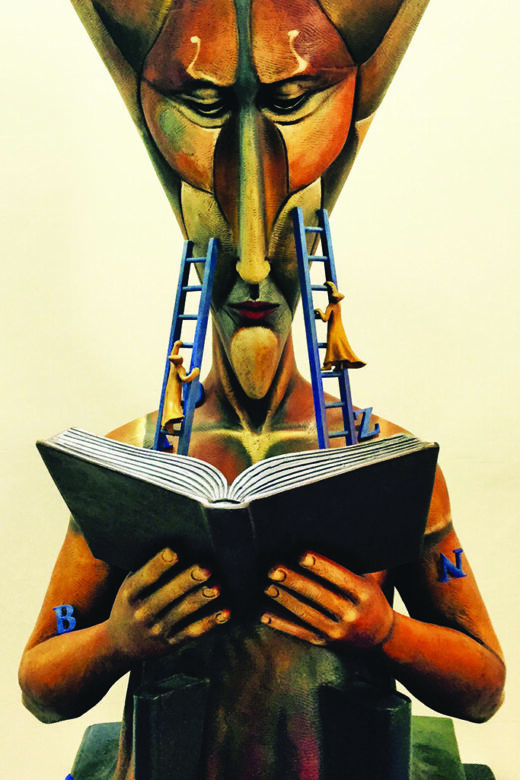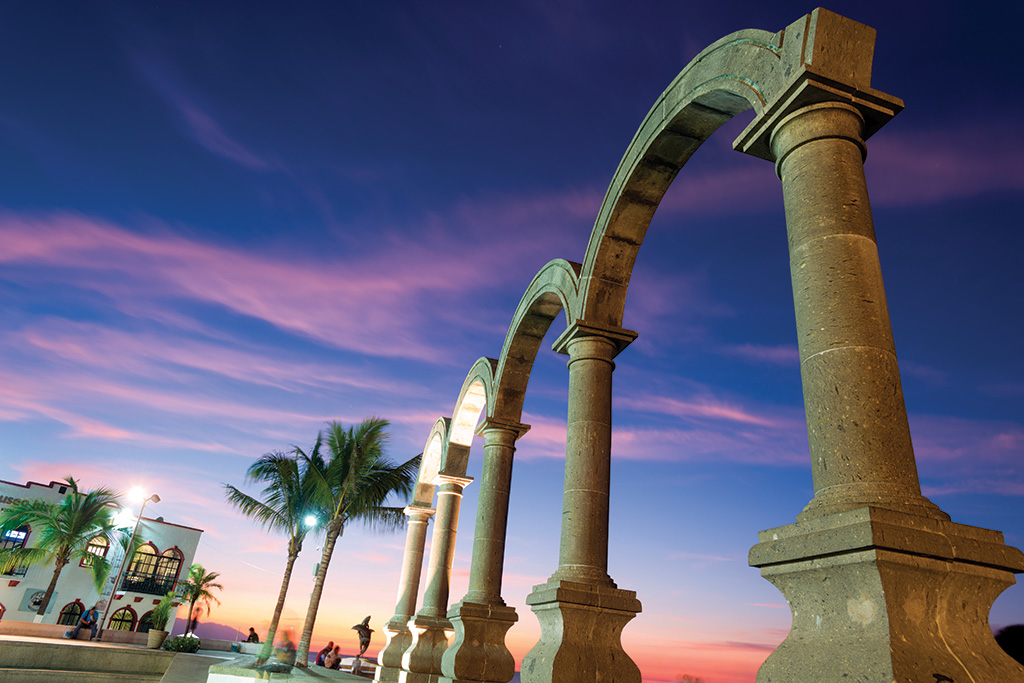I find a quiet bench in a small plaza. A cow sculpture clings sideways to the wall behind me with the words “Art Killer” written among other works of street art. Then, an alarm sounds from the University of Guadalajara and hundreds, upon hundreds of students and faculty descend upon the square causing pandemonium. Numbered signs stand tall against the gray skies. Professors shout orders. Students dash like Black Friday shoppers, and I dart through the crowds trying to make sense of the scene. Men in red ties stand on pedestals with news crews film- ing, and the crowd falls into a church-like hush as one man speaks into a megaphone and proclaims that the earthquake drill is a massive success.
My anxiety is alleviated, and the crowd takes on a structure. The signs mark each group’s floor from the building, a team leader carefully accounts for each person, and their once-chaotic movement is simply some schoolyard fire drill fun.
It’s this kind of organized disorder that attracts me to Mexico in the first place. Things in Mexico take context and take time to appreciate and understand. My experience during a whirlwind trip through Guadalajara and Puerto Vallarta is revealed with each turn of a street corner, each person I meet, and each piece of food eaten. At the end, I watch as it all comes together, and I see it through a new lens.

Vendor in Tlaquepaque. Photo: Paul West
The traffic comes to a complete halt in the center of Guadalajara, and we exit a cab leaving behind our frustrated driver whose days are filled competing with the city’s traffic. He touches the green, white, and red rosary hanging from his mirror and wishes us a good day. We cut through the centuries-old Plaza de Armas, dodging around uniformed boys and girls playing escondidas. They are climbing the intricate gazebo, bolting inside the cathedral walls, and hiding under a rubbed-for-luck statue commemorating a papal visit. The sun shines through the neogothic church spires and blasts bursts of colors from the French stained glass windows. We follow the exotic colors of tropical fruits being sold by the vendedores down a side street and bask in the cinnamon smell wafting from freshly made churros. We walk the cobblestone streets, nod- ding to a rotunda filled with Jalisco’s most famous son and carefully walk through a gaggle of elderly ladies who look dwarfed by the mighty colonial architecture as they wait for the crammed buses.
The city’s architecture gave it the nickname “The Pearl of the West,” and you can see why. A hodgepodge of styles that don’t always complement one another, but sure keep my eyes interested, with a faded color spectrum of corals and yellows with graffiti-covered walls slamming right up to 19th-century stone buildings. The people of Guadalajara, Tapatíos, take pride in their past. The city played a critical role in Mexico’s War of Independence and monuments to the revolution can be seen throughout, particularly in the work of José Clemente Orozco whose murals become a focal point of a quick city tour.
Our guide first leads us to the University of Guadalajara that houses Orozco’s murals “El Hombre Creador y Rebelde” and “El Pueblo y Sus Falsos Lideres” (“The Creator and Rebel” and “The People and Their False Leaders”), which adorn the dome and the walls of the university’s main lecture hall. Created in the mid-1930s, the painter, who had lost a hand as a child, created a haunting picture of education’s role on politics and ideologies set forth from the Mexican Revolution.
Attached are the galleries of MUSA Museo de las Artes that highlight contemporary artists in its high-ceilinged well-curated halls. We fall for the leather jackets and works of art by musician Sergio Arau who blends traditional Mexican folk art with modern-day culture and societal prob- lems. His series of half-dressed women with tattooed bodies all wearing lucha libre masks solidifies Arau as an artistic force in Mexico.
Diagonal from the Cathedral, the Palacio de Gobierno, which has been made public by the current government, demonstrates the grandeur of 19th-century architecture, but we’re more keen on spend- ing time admiring the artwork inside. One of José Clemente Orozco’s last murals can be found in the stairwell: a fire-and-brimstone warning to politicians about political ideologies, religion, and justice. Another in the state’s senate pays tribute to the great leaders of Mexico who ushered in democratic principles.
A cacophony of vendors and excitement fills the walk through the Old City’s two pedestrian streets, Paseo Degollado and Paseo Hospicio. Fortune-telling birds tweet from small cages with their owners competing for your dollar—the bird will select a piece of paper that will contain a message. Balloon animals, beaded necklaces, tacos, hot dogs, quinceañera photo shoots done in the most exquisite colors, you name it, the streets are filled with life. A fountain of children playing is a curious spectacle next to the legendary Devil’s Corner, a small street that for over a century has been the location of satanic sightings. “They put the children fountain there to make this corner a bit more cheerful,” our guide says so nonchalantly you’d think all cities contain devil’s corners.


Sculpture by Sergio Bustamante, Photo: Paul West
A visit to Orozco’s most famous work at the Hospicio Cabañas is as important as visiting the Sistine Chapel. Inside the massive compound, which was originally built to house in-need residents of the city, is the chapel thats sheer size is enough reason to visit. Looking up though, you’ll fall to the floor in sheer astonishment of the scale of Orozco’s work. Our guide has us running from corner to corner (you’ll notice other visitors doing so as well). Orozco was a master of perspective, and I’ve never encountered a work that accomplished this so dramatically. “Hombre de Fuego” (“Man on Fire”) in the dome moves in size, shape, and location, as do the other figures that make up the masterful scene.
While it’s easy to get lost in the whimsy of the city’s historic and arts-filled side, Guadalajara is a cosmopolitan center of Mexico. I book the Westin Guadalajara for its dramatic views, oversized rooms, and healthy approach to dining. My night starts with Chef Fernando Labra’s unforgettable meal at the hotel’s second-floor Grill and Vine restaurant. Seasonal and fresh ingredients bought from local providers highlight the region’s unique bounty. I salivate for his version of the traditional chiles en nogada (stuffed poblano peppers in walnut sauce) that is delicate yet robust, and is quite literally a celebration of Mexican cuisine, as it is only sold from August to mid-September when the ingredients, particularly the pomegranates, are in season. “You can get pomegranates at all times of the year,” I say. “But they are not Mexican,” Chef Labra replies, shutting me up quickly. Stop by the restaurant for breakfast and lunch and sample their SuperFoodRX menu that is designed to help you live your best with an assortment of complete food options and a made-to-order juice bar.
Later that night, I’m happy to meet up with local friends who insist we grab a drink at Romea, located on an unassuming corner near the University. We sit outside with Saúl Lomelí Guerrero, a PR maven, and his group of impossibly handsome friends who chat with us about life in the city. “Guadalajara has changed enormously since I was a teenager, people now come out when they are very young, most of my generation had to struggle for a long time to come out,” Guerrero says wiping beer from his Dalí-like mustache. He and his cohorts laugh over coming out stories and the changing Tapatío attitude, I can’t help but examine the thoroughly cool spot and watch the denizens converisng over charcuterie and cocktails. The conversation switches to what’s in at the moment in the city. “I have not lived in Guadalajara since 2010, but I come almost once a month or more, and I am constantly surprised to find new places all the time. Art, design, and culture are everywhere, and it’s very easy to find out what is hot or new just by looking around,” one of Saúl’s friends tells me. “Shopping from small independent stores is always a good idea like at Amor Apache and Albergue Transitorio to galleries like Tiro Al Blanco, Páramo Galería, and Curro y Poncho,” Saul adds. His friend butts in to tell us about the brand-new market called Vía Libertad that’s attracting international attention for its local products, high design, and stylish shoppers.


